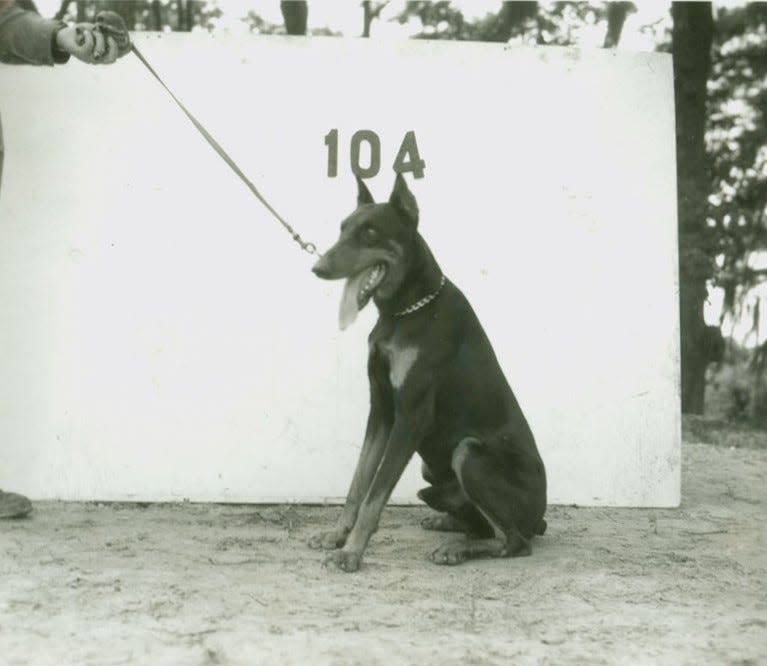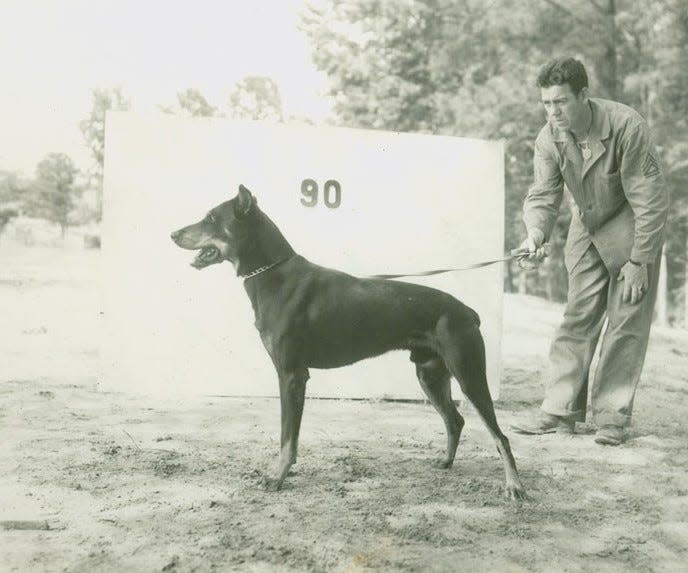The Monday After: Dog fighters of World War II

On New Year's Day 75 years ago – two years after World War II ended – a former sergeant in the United States Marines was reported to have come home a hero after serving overseas.
"Sgt. Sparks, Canton's famous marine corps 'devil dog,' is back in the United States," reported a brief article in The Canton Repository on Wednesday, Jan. 1, 1947, "after nearly two years of service in which he participated in major engagements in Bougainville, Peleliu and Okinawa and served in New Caledonia, Guadalcanal, Espiritu Santo, Guam, the Panama Canal and with occupation forces in Japan."
The moniker "Devil Dog" was more than a nickname that had been attached to each member of the Marines as early as World War I. Sgt. Sparks really was a dog. The canine Marine had been donated to the war effort – through the "Dogs for Defense" program – years before by a Canton man, as were dozens of other dogs from Stark County and thousands of pooches from throughout the United States.
And now the Sgt. Sparks was back in the United States serving as the "honored canine" at the dedication of what was then the nation's largest pet cemetery, a 27-acre war dog memorial at South Lyon, Michigan.
At the dedication, Sgt. Sparks' heroic deeds were recounted for those who were gathered for the event. The Repository recognized his war record in its New Year's Day article.
"Sparks, who 'hit the beach' on Empress Augusta Bay at Bougainville with the Marine Raiders and served in continuous action after that until relieved of combat duty."
His return home had surprised even his owner, who didn't know his former pet's fate immediately following the war's ending.
"Arthur S. Adams of 1420 17th St. NW, who donated his four-year-old Doberman pinscher for war service in March 1943, read stories of Sparks' deeds prepared by marine combat correspondents during the war, but then lost track of the dog after Sparks' discharge," the article in the Repository explained.
Adams had requested that Sparks be given to K.R. Shepherd, the dog's marine handler overseas. Shepherd, Adams said, had "pleaded so earnestly for him from the South Pacific."
However, the Marine Corps advised Adams that "it did not recommend the dog's return to a private home." Instead, the war-trained and battle-scarred dog was presented to John R. Patterson of Rochester, Michigan, near the cemetery in South Lyon. Patterson was an ex-marine who handled Sparks after the dog returned to the United States.
When did dogs go to war?
According to Marine Corps University, dogs have served in war "since ancient times."
"The Romans used the heavy Mastiffs with armored collars to attack their enemies in the legs, thus forcing them to lower their shields; first aid dogs were used in World War I; and, of course, all kinds and breeds of dogs have been used for centuries for pulling small carriages and sleds or as pack animals to transport light loads over difficult trails," recalled a historian for the research site. "In the 1920s, a Marine serving as an officer in the Garde d’Haiti trained a dog to work in the point of his patrols for the purpose of exposing bandit ambushes."
The Marine Corps' war dog training program was initiated in November 1942 at a Marine Corps training center in New River, North Carolina, a facility later designated Camp Lejeune.
"At that time one officer and 19 enlisted Marines were under training at the dog school at Fort Robinson, Nebraska, and four enlisted Marines were on temporary duty at Fort Washington, Maryland, in connection with training with dogs," said the history, noting that those Marines were ordered to bring their training back to the East.

Dog training program spreads
Recruitment of dogs spread throughout the United States, for use not only by the Marines but also by other branches of the military.
"Some 19,094 dogs were recruited by the Army at the time of the (K-9) corps inception in 1942," notes a column by Jane Eads published in the Repository on Aug. 22, 1947. "Of this number, 10,526 measured up to specifications, were trained and put into service."
Some of the dogs were purchased by the military, at a price of around $50. Many others were donated.
"All K-9 recruits had to weigh about 50 pounds and be from 23 to 24 inches high at the shoulder," wrote Eads. "The age range was from 14 months to three and a half years at the time of enlistment."
At the start of the military canine programs, five breeds – German and Belgian shepherd, Doberman pinscher, collie and giant schnauzer – were accepted, and were trained for scout and patrol work, Eads noted. Later recruits were limited to German shepherds, she noted, "which through the war years proved to be better all around for handling and training purposes."
"Also, the color of its coat, almost a camouflage in itself, won it first consideration."
While military branches recruited dogs at the start of the program, others were procured for the Marines through the Doberman Pinscher Club of America.
Dogs for Defense later contributed the largest number for both the Army and Marines. The private organization was headed by dog breeder Alene Erlanger of New York, but branches of her organization were spread throughout the country, including Stark County.
Several dozen dogs were donated through Dogs for Defense programs that were initiated in Canton, Massillon and other Stark County communities, articles in the Repository attest.
"Blitz Von Starkanhart," for example, was only a one-and-a-half-year-old Doberman when Harold Morris of Canton, chairman of the Dogs for Defense chapter in Canton, offered him to the cause of freedom. Officially, Blitz was donated by Canfield Oil Co., of which Morris was then manager.
Blitz was the first dog from Stark County to be donated through Dogs for Defense − his serial number was only 11 − the Repository noted in the caption to a photograph of Morris and Blitz. The photo was published in the Repository on Nov. 25, 1945, after the dog was discharged with the rank of corporal and returned home following two years of sentry duty in the Pacific.
Morris told the newspaper in 1945 that Blitz "presented no rehabilitation problem" after he was returned to him in October of that year.
"Blitz is just as gentle now as he was three years ago."
Some dogs stayed in service
Other military dogs were not of the same temperament following World War II.
A pictorial retrospective published in the Repository in 1993 noted that dogs who were accepted into military canine programs during World War II were considered "gifts" to the military and often stayed in service after the war. But, many were given back to their owners.
In her column, Eads explained that whether or not dogs could be returned to civilian life depended much upon their duties during wartime.
"Scout dogs were especially useful in jungle fighting in the South Pacific, where they could scent a man 300 to 400 yards away," she wrote. "Trained to alert and point without barking or whimpering, they saved hundreds of our boys from walking into a Japanese ambush.
"Patrol, or sentry, dogs were trained to attack, were one-man dogs, quick and fierce," she continued. "These were hardest to return to civilian life. They had to be de-trained before they could be considered safe, and a few had to be killed."
Of the dogs who were enlisted in the military canine corps, about 2,300 were war casualties. Scores of others were wounded, Eads reported. More than two dozen dogs were awarded citations for various acts of heroism or extreme intelligence.
Sgt. Sparks was one of the "lucky dogs."
After serving with distinction for much of the war, he was discharged with honors.
"Sparks," the Repository article about his homecoming said, "is entitled to wear the Presidential Citation with star and the Naval Unit Citation with star for the Okinawa campaign, Good Conduct ribbon, Japanese Occupational ribbon, Victory medal, Southern Pacific ribbon with three stars and the American theater ribbon."
Reach Gary at gary.brown.rep@gmail.com.
On Twitter: @gbrownREP
This article originally appeared on The Repository: Stark County dog fighters helped in World War II

